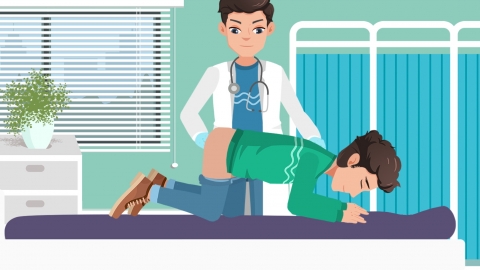What are the differences between anal fissures and hemorrhoids?
Generally speaking, the main differences between anal fissures and hemorrhoids include bleeding patterns, pain characteristics, lesion locations, inducing factors, and effects on defecation. If discomfort symptoms occur, it is recommended to seek timely treatment at a regular hospital. Detailed analysis is as follows:
1. Bleeding patterns
Anal fissures usually cause minor bleeding, often seen as blood on the surface of stool or dripping after defecation, noticeable when wiping with toilet paper, bright red in color, without jet-like bleeding; Hemorrhoidal bleeding may appear as dripping or jet-like bleeding, with varying amounts, bright red in color, not mixed with stool, and often stops spontaneously.
2. Pain characteristics
Pain from anal fissures is cyclical. Severe pain occurs during defecation due to the stimulation of the fissure by stool, subsides for a few minutes after defecation, and is followed by intense pain caused by anal sphincter spasm, lasting for a prolonged period; Hemorrhoids generally do not cause pain, but severe pain may occur when internal hemorrhoids prolapse and become incarcerated, or when a thrombosis forms in external hemorrhoids, causing sudden sharp pain in the anal area, with pain patterns different from anal fissures.

3. Lesion locations
Anal fissures are small ulcers formed by tears in the anal canal skin below the dentate line, commonly found in the posterior midline of the anal canal; Hemorrhoids are venous clusters formed by congested and dilated venous plexuses under the mucosa of the lower rectum and anal skin. Internal hemorrhoids are located above the dentate line, while external hemorrhoids are located below the dentate line.
4. Inducing factors
Anal fissures are often caused by dry, hard stools tearing the anal skin during constipation; frequent diarrhea and anal stenosis can also induce fissures; Hemorrhoids are commonly caused by increased abdominal pressure, such as straining during bowel movements due to constipation, prolonged sitting or standing, pregnancy, obesity, etc., leading to elevated pressure and tortuous dilation of the venous plexus.
5. Effects on defecation
Patients with anal fissures often fear defecation due to pain, easily forming a vicious cycle of constipation aggravating the fissure; Patients with hemorrhoids generally have no significant change in bowel habits, only a feeling of incomplete evacuation when internal hemorrhoids prolapse, or temporary fear of defecation due to pain.
In daily life, it is important to maintain a light diet, eat more fiber-rich foods, keep bowel movements smooth, avoid prolonged sitting, and maintain good anal hygiene to prevent the occurrence of anal fissures and hemorrhoids.





